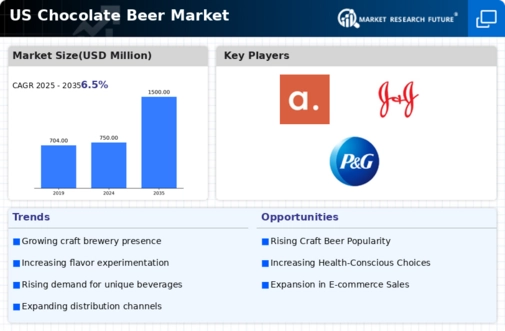Rise of Craft Breweries
The chocolate beer market is significantly influenced by the rise of craft breweries across the United States. Craft breweries, known for their innovative approaches and small-batch production, have become pivotal in introducing chocolate beer to a wider audience. As of 2025, craft breweries account for over 25% of the total beer market share, with many of these establishments experimenting with chocolate as a key ingredient. This trend not only enhances the variety available to consumers but also fosters a culture of creativity and experimentation within the industry. The craft beer movement encourages local sourcing of ingredients, which can include artisanal chocolate, further enriching the flavor profiles of chocolate beers. Consequently, the chocolate beer market benefits from the growing popularity of craft breweries, as they continue to push the boundaries of traditional brewing and attract adventurous drinkers seeking new experiences.
Evolving Retail Landscape
The chocolate beer market is experiencing changes in the retail landscape, impacting consumer access and purchasing behavior. The rise of e-commerce and online beer delivery services has made it easier for consumers to discover and purchase chocolate beers from the comfort of their homes. Recent statistics reveal that online sales of craft beers, including chocolate varieties, have increased by over 20% in the past year. Additionally, brick-and-mortar retailers are expanding their craft beer selections, often dedicating entire sections to flavored beers. This evolution in retail not only enhances visibility for chocolate beers but also encourages consumers to explore new brands and styles. As the chocolate beer market adapts to these retail trends, it is likely to benefit from increased accessibility and convenience, ultimately driving sales and market growth.
Health-Conscious Consumer Trends
The chocolate beer market is also shaped by the increasing health-consciousness among consumers. As individuals become more aware of their dietary choices, there is a noticeable shift towards products perceived as healthier alternatives. Chocolate beers, particularly those brewed with dark chocolate, are often marketed for their potential health benefits, such as antioxidants and lower sugar content. Recent surveys indicate that nearly 40% of consumers are willing to pay a premium for beverages that offer perceived health advantages. This trend is prompting breweries to develop chocolate beers that align with health-conscious preferences, potentially incorporating organic ingredients or lower-calorie options. As the chocolate beer market adapts to these evolving consumer demands, it may see a rise in products that cater to health-oriented drinkers, thereby expanding its customer base and enhancing market growth.
Seasonal and Festive Consumption Patterns
The chocolate beer market is influenced by seasonal consumption patterns, especially during holidays and special occasions. Chocolate beers are often marketed as seasonal offerings, appealing to consumers looking for indulgent beverages during festive periods. For instance, winter months see a spike in sales of chocolate stouts and porters, which are favored for their rich flavors and warming qualities. Data suggests that sales of chocolate-flavored beers can increase by up to 50% during the holiday season. This trend indicates that breweries are strategically aligning their product launches with seasonal events, creating limited-edition releases that entice consumers. As the chocolate beer market capitalizes on these consumption patterns, it is likely to see sustained growth during peak seasons, driven by consumer desire for unique and celebratory drinking experiences.
Growing Consumer Interest in Unique Flavors
The chocolate beer market is experiencing a notable surge in consumer interest in unique and innovative flavors. This trend is driven by a growing demographic of craft beer enthusiasts who seek out distinctive taste experiences. According to recent data, approximately 30% of consumers express a preference for flavored beers, with chocolate being one of the most sought-after options. This inclination towards flavor experimentation is reshaping the chocolate beer market, as breweries respond by developing new recipes that incorporate chocolate in various forms, such as cocoa nibs or chocolate malt. The increasing availability of these products in retail outlets and bars further fuels this trend, indicating a robust demand for chocolate-infused beverages. As consumers continue to explore diverse flavor profiles, the chocolate beer market is likely to expand, attracting both new and existing customers who are eager to indulge in these unique offerings.














Leave a Comment